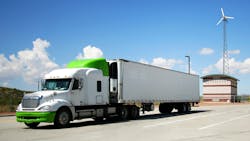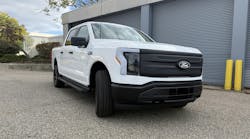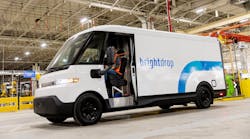Why fleets that just want to run diesel should care about the Messy Middle
Key takeaways
- NACFE’s Run on Less—Messy Middle showed top diesel fleets reaching 11.6 mpg through data-driven efficiency and disciplined operations.
- The study confirmed trucking’s shift toward purpose-built powertrains, with diesel, natural gas, BEV, and hydrogen each excelling in specific roles.
- NACFE’s findings highlight rapid innovation across all fuels—but infrastructure, weight, and cost still limit wide-scale adoption.
While the trucking industry's shift toward a reduced-emission future has been complicated by shifting regulations and economic pressures, there are several reasons why fleets that want to focus on diesel operations should care about the Messy Middle.
Even if you’re not interested in anything but diesel powertrains today, your future operations could depend on getting an edge over the competition tomorrow, according to Michael Roeth, executive director of the North American Council for Freight Efficiency (NACFE). “This is a highly messy thing—and clarity is going to be hard to get but will show up for some market segments and some people quicker than others,” he said during an October 23 virtual press briefing on initial findings from NACFE’s latest Run on Less study. “But we’re not naive. This is going to take a while.”
Years ago, NACFE began calling this growing period of powertrain evolution the “Messy Middle” because there are so many emerging technologies that it’s unclear what will be the winning solution for over-the-road freight—and how long it will take the trucking industry to get there.
This year, the not-for-profit research organization’s Run on Less—Messy Middle featured on-board studies with 13 participating fleets operating from coast-to-coast using four different powertrains over 18 days. NACFE shared a preview of the data with industry media this week. It plans to share a full report on the Run early next year with a published study and an in-person gathering.
Why diesel fleets cannot afford to ignore the emissions evolution
The Run on Less—Messy Middle showcased the state of long-haul decarbonization across four distinct powertrain categories. According to Roeth, it was conducted to bring clarity to this confusing period.
NACFE’s findings are not just for fleets considering electric or hydrogen powertrains; they are a critical competitive blueprint for the entire industry. When asked by FleetOwner why this should matter to fleets that are content to keep running diesel, he offered three arguments:
- Understand your business data: "You've got to understand the data of your business, or you're just done." Roeth warned that making decisions based on gut instinct rather than using the vast amount of available data will lead to competitive trouble.
- Burn less diesel: "Just work on burning less diesel." This is the best short-term effort a fleet can make for its bottom line. Investing in idle management, speed management, aerodynamics, and driver training is an initiative that starts saving money immediately.
- Stay engaged and educated: Roeth stressed that competitors who are smarter and better informed about emerging technologies—be it biodiesel, natural gas, or batteries—are better suited to specific duty cycles and will gain a significant competitive edge.
Five key findings from Run on Less—Messy Middle
The Run on Less event featured 14 trucks across 13 fleets and was dubbed the most comprehensive in NACFE's Run on Less history, which stretches back to 2017. The initial findings highlight a trucking industry that is rapidly segmenting, with multiple technologies improving simultaneously and vying for specific use cases.
Here are the five key findings NACFE announced:
1. Cost and performance will always win
The industry’s fundamental challenge remains the same: Powertrain technologies must compete directly on cost and performance. While shifting regulations and incentives can affect the challenge, the market will ultimately decide what works based on reliability and durability. As Roeth noted, this will happen "anyway, whether we have regulations or not."
2. Sustainability is not going away
Despite the current economic climate and regulatory uncertainty, sustainability efforts are a permanent priority. Fleet owners, their customers, and the public all continue to drive businesses toward greater sustainability while still seeking good returns on investment.
3. The truck market is segmenting and purpose-built
The days of the "Swiss Army knife of trucking"—a single truck model designed to do all jobs—are over. Trucks are becoming more "purpose-built" for specific tasks, creating a significant challenge for OEMs, which are now being asked to offer a wider array of specialized solutions.
4. Significant advancements are fueling the transition
The pace of innovation is accelerating across all platforms. Recent significant advancements include:
- Diesel/renewable diesel: Increased availability of bio and renewable diesel
- Natural gas: Debut of a 15L natural gas engine, which allows natural gas to satisfy the needs of diesel with more power and torque
- Battery electric: Trucks capable of 400-plus-mile ranges and the rollout of high-power fast charging stations
- OEMs: New high-volume OEM entrants
5. Challenges persist in infrastructure, weight, and cost
While all technologies are improving, three challenges persist across alternative powertrains: fueling/charging infrastructure, weight, and cost. Furthermore, while production of renewable fuels is increasing, it remains well below what is needed for wide-scale adoption.
Real-world perpformance data
The NACFE study provided concrete data points that highlight the current capabilities of each solution:
Diesel and renewable fuels
Fleets continue to find ways to maximize conventional diesel:
- Two diesel trucks traveled 22,550 miles at an overall average of 11.6 mpg. Roeth noted this rate—driven in part by one fleet using two-driver teams to maintain lower speeds—is what "the best of the best are putting up."
- A truck running on 99% biodiesel ran 5,418 miles at 9.5 mpg.
Natural gas
The new 15L Cummins engine enabled natural gas trucks to handle the most challenging jobs:
- Three natural gas trucks ran 20,739 miles on challenging routes, hauling multiple trailers (triples and doubles) at gross vehicle weights often over 120,000 lb.
- The fleets primarily used renewable natural gas (RNG) contracts. NACFE concluded the Run showed natural gas trucks can do the job of more complex diesel operations.
Battery electric
BEVs demonstrated surprising range and utility:
- One BEV completed 465 miles on a single charge.
- A Tesla Semi used in a slip-seated operation covered 3,676 miles over 18 days. This truck was only on a charger for 13% of the time and needed less than two hours of charging to complete its 465-mile run.
- A third BEV covered 5,740 miles over 18 days, including 875 miles in a single day, using only public charging.
Hydrogen fuel cell
The technology is still nascent but proving itself in targeted urban routes:
- A hydrogen fuel cell truck demonstrated 100% uptime, covering 4,076 miles over the run with a top day of 411 miles. The efficiency was recorded at 7.8 miles per kg H2.
What comes next for the Run on Less-Messy Middle?
NACFE is currently conducting a deeper data analysis that will inform the industry for months to come.
- A complete data set will be released on November 3.
- A full report on the mechanics of the Run will be published in January 2026.
- A "Potluck" style data analysis workshop will be held in February 2026 in Boulder, Colorado, where industry stakeholders are invited to present their own analyses of the event data.
- A detailed final analysis of all findings will be published by mid-2026. The analysis will be examined from three critical angles: operational performance, total cost of ownership (TCO), and emissions.
About the Author
Josh Fisher
Editor-in-Chief
Editor-in-Chief Josh Fisher has been with FleetOwner since 2017. He covers everything from modern fleet management to operational efficiency, artificial intelligence, autonomous trucking, alternative fuels and powertrains, regulations, and emerging transportation technology. Based in Maryland, he writes the Lane Shift Ahead column about the changing North American transportation landscape.



